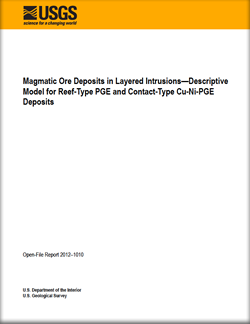 Concise Description
Concise Description
Layered, ultramafic to mafic intrusions are uncommon in the geologic record, but host magmatic ore deposits containing most of the world’s economic concentrations of platinum-group elements (PGE) (figs. 1 and 2). These deposits are mined primarily for their platinum, palladium, and rhodium contents (table 1). Magmatic ore deposits are derived from accumulations of crystals of metallic oxides, or immiscible sulfide, or oxide liquids that formed during the cooling and crystallization of magma, typically with mafic to ultramafic compositions.
“PGE reefs” are stratabound PGE-enriched lode mineralization in mafic to ultramafic layered intrusions. The term “reef” is derived from Australian and South African literature for this style of mineralization and used to refer to (1) the rock layer that is mineralized and has distinctive texture or mineralogy (Naldrett, 2004), or (2) the PGE-enriched sulfide mineralization that occurs within the rock layer. For example, Viljoen (1999) broadly defined the Merensky Reef as “a mineralized zone within or closely associated with an unconformity surface in the ultramafic cumulate at the base of the Merensky Cyclic Unit.” In this report, we will use the term PGE reef to refer to the PGE-enriched mineralization, not the host rock layer. Within a layered igneous intrusion, reef-type mineralization is laterally persistent along strike, extending for the length of the intrusion, typically tens to hundreds of kilometers. However, the mineralized interval is thin, generally centimeters to meters thick, relative to the stratigraphic thickness of layers in an intrusion that vary from hundreds to thousands of meters.
PGE-enriched sulfide mineralization is also found near the contacts or margins of layered mafic to ultramafic intrusions (Iljina and Lee, 2005). This contact-type mineralization consists of disseminated to massive concentrations of iron-copper-nickel-PGE-enriched sulfide mineral concentrations in zones that can be tens to hundreds of meters thick. The modes and textures of the igneous rocks hosting the mineralization vary irregularly on the scale of centimeters to meters; autoliths and xenoliths are common. Mineralization occurs in the igneous intrusion and in the surrounding country rocks. Mineralization can be preferentially localized along contact with country rocks that are enriched in sulfur-, iron-, or CO2-bearing lithologies.
Reef-type and contact-type deposits, in particular those in the Bushveld Complex, South Africa, are the world’s primary source of platinum and rhodium (tables 2 and 3; fig. 2). Reef-type PGE deposits are mined only in the Bushveld Complex (Merensky Reef and UG2), the Stillwater Complex (J-M Reef), and the Great Dyke (Main Sulphide Layer). PGE-enriched contact-type deposits are only mined in the Bushveld Complex. The other deposits in tables 2 and 3 are undeveloped; some are still under exploration.